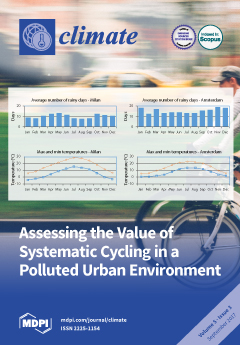The urban heat island effect (UHI) for inner land regions was investigated using satellite data, ground observations, and simulations with an Single-Layer Urban Canopy Parameterization (SLUCP) coupled into the regional Weather Research Forecasting model (WRF,
http://wrf-model.org/index.php). Specifically, using the satellite-observed surface skin
[...] Read more.
The urban heat island effect (UHI) for inner land regions was investigated using satellite data, ground observations, and simulations with an Single-Layer Urban Canopy Parameterization (SLUCP) coupled into the regional Weather Research Forecasting model (WRF,
http://wrf-model.org/index.php). Specifically, using the satellite-observed surface skin temperatures (T
skin), the intensity of the UHI was first compared for two inland cities (Xi’an City, China, and Oklahoma City (OKC)), which have different city populations and building densities. The larger population density and larger building density in Xi’an lead to a stronger skin-level UHI by 2 °C. However, the ground observed 2 m surface air temperature (T
air) observations showed an urban cooling island effect (UCI) over the downtown region in OKC during the daytime of 19 July 2003, from a DOE field campaign (Joint Urban 2003). To understand this contrast between satellite-based T
skin and ground-based T
air, a sensitivity study using WRF/SLUCP was analyzed. The model reproduced a UCI in OKC. Furthermore, WRF/Noah/SLUCM simulations were also compared with the Joint Urban 2003 ground observations, including wind speeds, wind directions, and energy fluxes. Although the WRF/SLUCM model failed to simulate these variables accurately, it reproduced the diurnal variations of surface temperatures, wind speeds, wind directions, and energy fluxes reasonably well.
Full article





